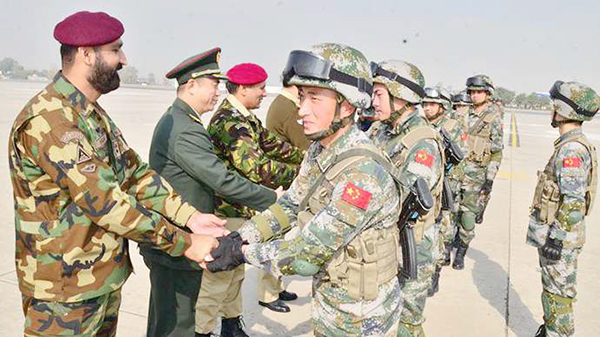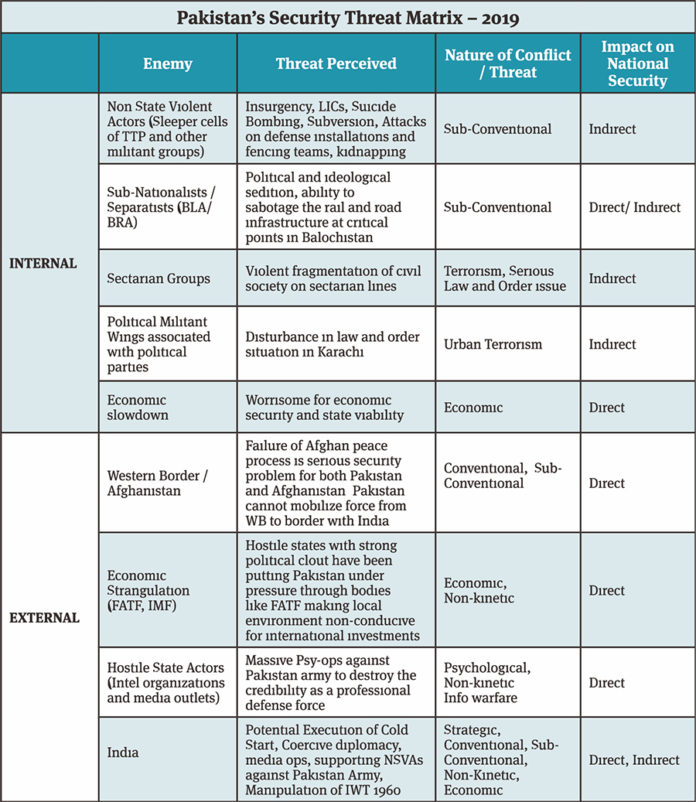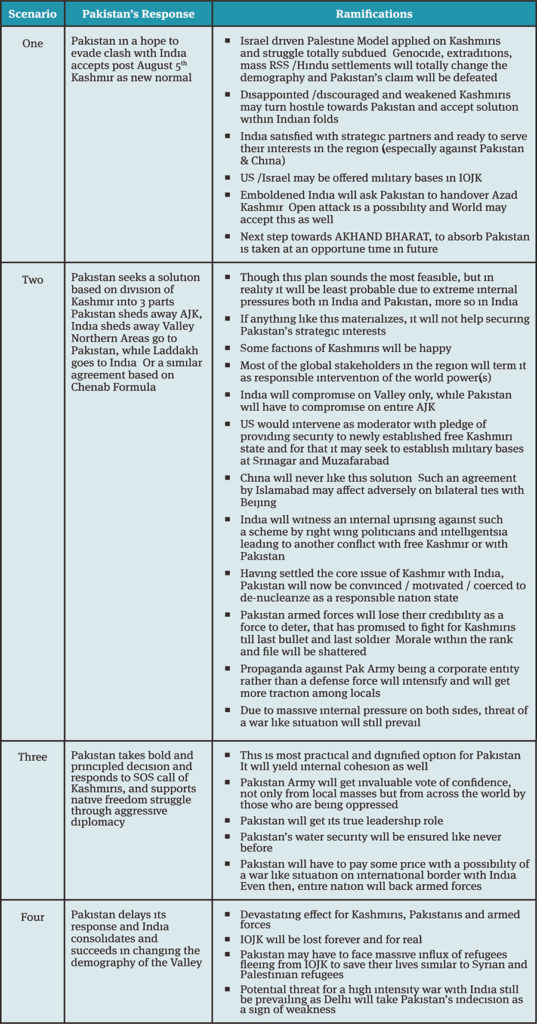Farzana Shah
Farzana Shah is a Peshawar based journalist. This is an abridged extract of an article which was first published in the Pakistan Army Green Book 2020. The views expressed do not reflect the views of IMR
On August 5th, 2019 India unilaterally revoked Article 370 of its Constitution which promised autonomy to the state of Jammu and Kashmir, i.e., Indian Occupied Jammu and Kashmir (IOJK). This unlawful decision with its dire pending consequences has triggered an outrage, not only in the region but also at the global level. The entire state has been put under siege with total communication blackout, enforced by deploying thousands of fresh troops. Over 3000 political figures including former chief ministers of the state were arrested under so-called Public Safety Act (PSA).
India also divided the state into two; an act through which she changed the geography of the disputed land, hence practically ending the 1971 Simla Agreement. This agreement has remained a critical milestone for both Pakistan and India, as it was this agreement based upon which both countries established what the world later on recognized as Line of Control (LoC). Not only that, August 5th action also undermined the very foundation of Indian constitution, as Article 370 was obliterated without the essentially required consent of state government and that’s why this action was not a constitutional reform, but a blatant coup in total disregard to the pending UNSC resolutions /UN Charter.
Modi government with full backing from hardliner Hindu groups, abolished IOJK’s autonomous status under a fabricated security threat perception to conceal the real intent. Pak-US peace overtures in Afghanistan had made Delhi very nervous because of the simple fact that any settlement between the US and Taliban would have enabled Pakistan to move almost 200,000 of its troops or at least a large number of these to its eastern borders in Kashmir and elsewhere. Indian desperation to counter Pakistan and limit her growing role in Afghan peace process led to such an abrupt abrogation of special status of IOJK and this timing was no coincidence.
Media reports suggest the Indian intelligence agencies were desperately waiting for this opportunity to strike. Delhi had sensed that a possible deal managed by Pakistan for US troops’ withdrawal from Afghanistan could eventually renew US military assistance for Pakistan.
Reportedly, to scuttle Afghan peace deal and legitimize Indian stance over Kashmir, Indian spy agency RAW’s new chief Samant Goel called on Narendra Modi on July 5th, 2019 and apprised him of the plan to abolish the Article 370 for IOJK. Preparations for the move were already in place in Delhi as a number of high profile military and intelligence visits were made to IOJK including those by RAW’s chief Goel, Indian NSA Ajit Doval and Indian Army Chief General Bipin Rawat in the months preceding August 2019. On July 24, Doval also held a meeting with Indian military chiefs and heads of all three intelligence agencies including National Technical Research Organization (NTRO), in the same context.
Media also reported that India had flown Israeli Heron drones across the Pir Panjal range to rehearse controlling mob in case of protesteruption3; military aircrafts made a number of sorties flying relief supplies including food, water and medicines into the Valley for the Indian troops.
After Indian decision of obliteration of Article 370, LoC has become potential conflict with Pakistan under the nuclear overhang because of the simple fact that Delhi has changed the goalpost for future talks on Kashmir. According to Indian leadership, now talks will be on Azad Jammu and Kashmir.
Post August 5th environment suggests that India with obliteration of Article 370 actually risked a high intensity insurgency in an already volatile state of IOJK; something India could not have done alone without external backing.
Pakistan’s Current National Security
Predicaments Developments in IOJK are neither random nor isolated as far as their impact on Pakistan’s national security is concerned. It is a dilemma imposed by our geography that Pakistan cannot stay isolated from regional developments. Even in some cases, extra regional developments also impact Pakistan’s security milieu; fast evolving situation in Middle East and ongoing trade war between US and China, are cases in point.
United Nations on April 21, 1948 adopted Kashmir resolution after India took the issue to the UN under article 35 of Chapter VI. Kashmir was declared disputed territory and call for a plebiscite was made as the said chapter outlines the means for a peaceful settlement of disputes. The shadowy annexation of IOJK by India and insistence upon
its fabricated history has resulted in 3 out of4 Indo-Pak wars. With current clampdown on basic human rights in IOJK, there is a clear and present danger of yet another round of conflict. LoC is already red hot; both countries are already exchanging artillery fire. Earlier, in February 2019,both sides deployed air power. India lost 2 fighter jets on 27/2 with one pilot becoming POW; who was immediately returned by Pakistan as a goodwill gesture.
India is desperate to get a role in the region, belittling what Pakistan has been doing for regional stability. This is critical for India to present Pakistan as a perpetrator of global terror, while fact is Pakistan has been the biggest victim of non-state actors’ actions within and without.
Two most important strategic goals of India are:
• Bigger role, both in the region and world.
• Solving Kashmir through UNSC resolutions, but after changing its demography to ensure a win. Solving Kashmir will pave the way for permanent UNSC seat; vital prerequisite for India to embark on Akhand Bahart agenda of RSS.
Indian threat has been intensified even more after August 5, 2019. Kashmir has dominated the security debate as it’s going to impact both internal and external security dynamics. How things will unfold in coming weeks and months, depends on how Pakistan formulates and executes its strategy on Kashmir.
Apart from the traditional foe in the east, the country has been fighting an endless war on the west, which despite clear gains, remains a perpetually bleeding front albeit with reduced fatalities.
Notwithstanding these obvious kinetic threats, Pakistan’s security landscape is inevitably affected by certain other factors as well, like peaceful rise of China and her ensuing trade war with the US, culmination of US’ longest war in history in Afghanistan and growing strategic competition around various parts of Asia including South China Sea, Indian Ocean, North Korea, and stand-off between US allies in Strait of Hurmuz against Iran. All these geopolitical development swill directly or indirectly impact Pakistan. Hence, it is likely to continue to be in the eye of global security storm due to its geography and may continue to suffer if not steered wisely.
Pakistan’s Significance to China
Chinese trillion-dollar Belt & Road Initiative(BRI) is pivotal for turning China into a world commercial empire. The region of Azad Jammu and Kashmir gains unprecedented importance in the wake of US-China emerging geopolitical competition worldwide. US wants to hit CPEC just like India for almost similar reasons; CPEC has in fact comprehensively demolished the US envisaged strategic encirclement of China in South China Sea, notwithstanding US quadrilateral alliance with Japan, Australia, and India. Idea was that CPEC brings global connectivity to China, so that Beijing can invest hundreds of billions of US dollars in its reserves to reignite the growth engine, which has slowed down during last 5-7 years (from10% annual to 6.5%). Beijing has plans to expand BRI to 70 countries and CPEC remains a critical part of this Chinese enterprise. Road to China’s strive for challenging American dominance passes through CPEC.
Apart from this economic dimension, the north eastern region of IOJK is attractive due to its close proximity to Russia, China and Pakistan. The Indian action in IOJK gives the US deep state an opportunity for furthering its own scheme of geopolitical maneuvering in Afghanistan, which is instrumental in containing Russia-China-Pakistanat the same time.

While US has remained stranded in Afghan quagmire, China’s BRI has been helping Beijing in positioning China to rise peacefully as a peace broker to the conflict zones like Afghanistan and Iraq in near future through trade compulsions. These very aspects substantiate the growing geostrategic prominence of Pakistan /Kashmir.
The changing geopolitics has forced Pakistan to adopt a more robust offensive maritime policy, apart from safeguarding its interests attached to land component of CPEC. Pakistan Navy has embarked on an ambitious project of acquiring eight submarines along with multiple advanced naval ships. All these may help restore some balance of power in South Asia /IOR.
China – India – Pakistan Paradigm
Recent, Sino-India skirmishes in Doklam went full circle in locking both the nuclear powers into a possible warlike situation. India has recently expressed her envisioned two front war strategy, which basically relies on the premise of preventing Chinese ingress across the LAC amid a high intensity short lived Indo-Pak conflict adopting Cold Start Doctrine (CSD). After initial denial, the top Indian military brass has not only publically acknowledged its presence, but has also hinted at considering unleashing CSD against Pakistan.
Indian aggressive attempts to outmaneuver Pakistan’s nuclear threshold forced it to adopt a full spectrum deterrence posture, while retaining/displaying the resolve to adopt policy of first use. Though it carries a great promise of strategic stability, but still there is a sizeable Indian defense intelligentsia that conceives this as a weakness in conventional balance of power, hence sees an opportunity of a limited, high-intensity conflict aimed at shallow gains across LoC/IB. This community of India is of the view that such gains will serve a devastating blow to Pakistan’s national morale. Indian strategy is to choke Pakistan economically, while raising cost of its deterrence by triggering an arms race.
Adding current volatile situation in IOJK into above discussed strategic contest between conventional Indo-Pak militaries and growing US-China wrestling for dominance, it would be safe to assume that the probability of an armed conflict in this region was never this high in last 72 years, as it is now.
Critical Appraisal of Pakistan’s Response Strategy
Let us begin with the most critical question, i.e., if all these preparations as highlighted in earlier part of this discourse were underway in India, why Pakistan remained oblivious to these developments about IOJK or was it caught totally unaware /surprised like rest of the World? A critical and candid appraisal is needed.
It would be safe to assume that Pakistan missed the opportunity to preempt and did very little or nothing before August 5th on diplomatic and media fronts to expose and pressurize India. Whatever and wherever it reacted, it did once unilateral annexation of IOJK by Modi had already occurred.
In the wake of Indian move over IOJK, Pakistan repeatedly reiterated its intention to undertake preventive measures to counter threats hurled by India. Such a move had always been seen by the US and her allies as jeopardizing War on Terror, a metrics which puts Pakistan at a crucial position with regard to peace in the region. The equation exhibits importance of Kashmir conflict and consequences of Indian attempt of redrawing map of erstwhile Jammu & Kashmir for the world peace and stability.
On international fora, India always presented Kashmir as a bilateral issue, supposed to be solved under Simla Agreement at bilateral level without any third party intervention. While on the bilateral level, Indian policy on Kashmir is immoveable as it always maintains that Kashmir is an integral part of Union, hence no bilateral dialogue is possible. On the contrary, India showed willingness to discuss Azad Jammu Kashmir and Northern Areas(parts of heretofore Kashmir state) of Pakistan for which nation gave blood in 1947-48 to liberate from the clutches of Dogra Raj; putting added pressure on our diplomacy.
Despite the fact that since 9/11 Pakistan’s security challenges have grown manifold, it has made abundantly clear that Pakistan cannot and will not remain oblivious from what goes on inside the Kashmir valley; any undertakings however, demand a comprehensive understanding of the total security paradigm. Pakistan will have to work pro actively and diplomatically support the indigenous KFM, else the state will be dragged into yet another regional conflict with India, giving her the advantage to choose time and place of her liking.
Notwithstanding initial surprise, post August 5th Pakistan’s political leadership has repeatedly and quite forcefully warned the World at large about the potential threat to global peace emerging from regional conflict in Kashmir in near future; it’s a nuclear flashpoint that has the latent potential to engulf the entire world.
Geo-Strategic Implications
Strategically speaking, the clash of interests among big powers alone makes Kashmir a bone of contention; contested directly by three nuclear powers (intrinsically linked are the strategic interests of two extra regional nuclear powers i.e. US, Russia).
Gilgit-Baltistan region has for centuries been the most vital part of Jammu and Kashmir. It is now a key part of CPEC, the cornerstone of China-Pakistan axis and the flagship project of China’s BRI for global trade domination; it aims at connecting South Asia with Europe, Central Asia and the Middle East /Africa; the shortest route from Arabian Sea ports of Karachi and Gwadar.
The growing competition in different fields(fanning economies and military insecurities) is forcing China and India to gain access to energy rich CARs. International North-South Transport Corridor (INSTC) was envisioned by India as alternative to CPEC. This corridor connects CAR to Iran and to India through Arabian Sea. Obviously, the route is not only much costlier due to its length, but also tremendously insecure as it goes through Iran and Persian Gulf, regions far from stable for long term investments and economic activities. The only alternative short and direct route for India passes through Azad Kashmir and Pakistan’s northern areas. Sooner or later, India will make a move to extend its jurisdiction over this area; current overture in IOJK may have this latent desire imbedded in it.
Apart from economic and strategic dimensions, Kashmir issue has become a cultural and social question as well.
Modi is planning to change the religious demography of IOJK, through ethnic cleansing and Hindu settlements in disputed territory on the lines of Jewish settlements by Israel. This drive itself is being fueled by right-wing Hindutva gangs, who have taken over India and have completely distorted her secular face. Hindutva ideology, much like Hitler’s Nazism, believes in supremacy of their own faith and considers all minorities in India as impure and hence, must be culled from Indian soil.
Modi appealed to the Indian society to”embrace Kashmiris” on Independence Day. It was sensible from both the domestic and international perspectives. But the news coming out of IOJK and even from mainland India, indicates that Hindutva’s control over Indian society has put Indian minorities in grave danger. Lynching of Muslims and Kashmiri students even within Indian cities has become new normal. This explains why Modi was compelled to ensure a complete media clampdown in the IOJK. Apart from that, Modi is now faced with severe internal pressure to act against Pakistan on AJK.
Apropos, it is beyond any doubt that the current fascist regime in India has nefarious designs against Pakistan /Muslims. Ruling RSS/ VHP/BJP has built anti-Muslim/anti-Pakistan sentiment so hard in Indian mainstream media and public discourse that BJP will have to continue undertaking some sort of anti-Pak overtures every now and then, to stay in power; hence current misadventure should not be taken as last.
Possible Emerging Scenarios and their Impact on Pakistan’s National Security
It is evident from the analysis so far that an Indo-US-Israel nexus is at play against Pakistan at multiple levels to close the Kashmir chapter once and for all. Hence, it is now prudent to examine the possible outcomes of Indian political discourse vis-à-vis Pakistan (Table Opposite).
A critical appraisal of the above scenarios suggests that Pakistan will have to walk a very thin line to fight for the Kashmir cause. Biggest challenge is that Pakistan will have to take the initiative and yet not to be seen as an aggressor as per international law. Having tested Pakistan’s response in February 2019, India may not escalate the situation along LoC any further than routine ceasefire violations, without consolidating control over IOJK. India’s best bet in current scenario is to maintain status-quo with a complete information and media control on developments inside IOJK particularly in the valley. This is where Pakistan will have to respond along with aggressive, non-apologetic and bold diplomacy. Proactive Foreign Office (FO) will produce results. If Pakistan keeps waiting for Indian action to react; Islamabad will be playing a losing game from the very onset.
Policy Recommendations
So far, Pakistan has given a standard response to Indian action of August 5th. Prevailing security crisis however, demands a robust and out of box solution, and that too in quick time. International community at best, will not go beyond condemning India over human rights violations in IOJK. In order to do that Pakistan will have to take the war into non-kinetic domains:
• Information / Cyber Warfare
• Electronic Warfare (EW) Spectrum
Relevant establishments must provide support to diplomatic efforts being done by government through operations in these two domains with focused goal of extracting authentic information from stakeholders in IOJK most importantly from general public facing the brutalities of Indian oppressive forces. Once information gathered, FO must disseminate it with proper narrative of the state of Pakistan.
A single video clip or picture can change the perception of India, which it has built so painstakingly over the years. Pakistan needs to keep world attention on IOJK and in order to do that communication links inside the valley must be established. Indian decision of communication blackout in IOJK was not random, but part of the planning. Pakistan’s response in these two domains will be purely non-kinetic, denying any involvement of arms. If executed properly anda local uprising occurs inside IOJK, it will make it extremely difficult for India to keep selling the terrorism card on IOJK. Burhan Wani was a local hero, India could not blame his action on Pakistan. Only a native uprising will be just and politically defendable for Pakistan on international forums. Even such an uprising will need support in the information domain.
EW Spectrum would be critical as it will enable Pakistan to keep Indian preparation in check. There is a possibility that India creates a deception in IOJK and opens war across IB on a spot like Pakistan’s soft-belly (Rahim Yar Khan – Kashmore) to sever Karachi from rest of Pakistan. There are rumors suggesting similar planning going on in Indian military headquarters; Pakistan must take requisite safeguards.
Pakistan must also keep refining standard diplomatic response along with taking into consideration above mentioned suggestions. Few areas where improvement can be made are mentioned below:
• Pakistan, according to UN charter, can openly help Kashmiris in their fight. Indian intervention in East Pakistan and recent Syrian conflict between Russia and the US are clear examples.
• India may try to capture areas 5 to 7 km inside AJK to make claim on the area. Pakistan army must have own similar plans and be executed preemptively.
• Question of Kashmir must be debated among legislators on regular basis so that policy can be kept proactive rather than calling session of parliament on special occasions. Kashmir’s importance as vital strategic national interest must be seen by whole nation. Kashmir demands and deserves more pragmatism than emotional outburst.
• Pakistan’s foreign policy needs more consistency, more inclusiveness of security institutions and constant review of emerging developments around the world particularly in South Asia.
• Kinetic intervention from Pakistan has proven counter-productive as far as larger goals of Kashmir’s freedom is concerned. It created problems locally as well. State must adopt transparent policy in this regard. Proscribed organizations must remain ineffective and immobile.
• Pakistan must establish a dedicated and permanent desk at FO focused on human rights violation in India against minorities. These efforts must be driven not by shallow patriotism, but true humanitarian grounds. In this regard, contacts must be established with oppressed groups within Indian society. This desk must be tasked to constantly arranging seminars and programs for this single purpose. Kashmir Committee must work along with this desk.
• Especial efforts must be put on proactive diplomacy on Kashmir in P-5 nations. Pakistan embassies must conduct seminars, conferences and round tables with local intellectuals about Indian oppression in the valley.
Conclusion
Indian government has gravely endangered the global peace by unilaterally changing the status of disputed state of Jammu and Kashmir. Due to RSS/BJP actions in IOJK, future of 8 million Kashmiri Muslims is at stake with a probability of their systematic genocide or forced exodus from their native land. The subsequent strategic situation demanded an appraisal to assess the way forward for the state. This paper is an attempt in the same direction. It argued and examined various vertices of Kashmir’s geography, its linkage with national security and impacts of various policy options. Pakistan will have to act proactively. Standard diplomatic response will not be enough and a delay in decisive line of action will be suicidal.
Pakistan must ensure regional peace by adopting an aggressive and just policy on Kashmir, while also ensuring that state must not be seen as aggressor till the time an armed conflict with India becomes inevitable. Information and EW Spectrum domains must be explored for non-kinetic operations against Indian political and military leadership so that Pakistan can expose Indian atrocities and can achieve higher moral ground before any open conflict.



















